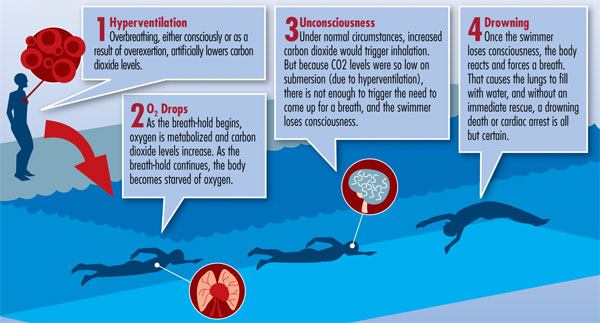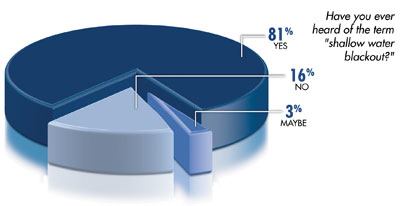NICK ORABOVIC
They were supposed to make headlines as heroes. Instead they ended up on front pages around the world as victims.
By all accounts, Bohdan Vitenko and Jonathan Proce, both 21, were preparing for careers with elite military units. Vitenko hoped to become a Navy SEAL and Proce, a lifeguard at another pool, was heading to train for the Air Force’s Battlefield Airmen commandos, similar to the Navy SEALs unit.
Both young men were strong and fit. Witnesses at Lyons Pool in Tompkinsville, N.Y., on Staten Island, had seen them exercising in the water regularly in pursuit of their dreams, according to the New York Post.
That’s what got them into trouble on the morning of July 13, when the two were pulled unconscious from the water. Despite rescue attempts, they went into cardiac arrest. Vitenko was pronounced dead that morning. Proce died about four days later. It appears they had been using prolonged underwater breath-holding as part of their training — and that was their fatal mistake.
Other athletes and swimmers continue to make the same mistake. And the tragedy it causes may be on the rise, say some experts.
Holding your breath underwater is part of swimming, and under normal circumstances, breathing as needed, there’s no danger. That changes when you hold your breath repeatedly for extended periods underwater, which is typically done for training or endurance purposes. Preceded by hyperventilation (sometimes called overbreathing) it can be fatal: death by what’s collectively known as shallow water blackout.
While aquatics professionals know what shallow water blackout is — more than 80 percent recognized the term in a recent online poll of 566 Aquatics International readers — a much smaller number seem to fully grasp how it’s caused or its true risk. For example, nearly 90 percent surveyed labeled prolonged breath-holding as dangerous. But 40 percent also said they don’t have rules at their facilities forbidding the practice.
Despite the known threat, some coaches still regularly use breath-hold training. Lifeguards — the first defense against drowning — are not being fully or consistently trained on how to spot the risks, especially because the victims often are strong swimmers, say experts interviewed for this story.
Within those disconnects, people are dying.
The Divers Alert Network has tracked drownings linked to breath-holding for more than five years and reports at least 44 fatalities each year since 2004. In 2010, an analysis published in the Southern Medical Journal identified eight breath-holding related deaths in a survey of 180 pool drowning incidents that occurred between 1998 and 2008.
But those numbers only scratch the surface. “My expectation is, we’re clearly not seeing how many cases where hyperventilation is a factor,” says Neal Pollock, Ph.D., research director at the nonprofit DAN.
That’s because when someone dies as a result of excessive breath-holding, no forensic evidence is left behind to tell the story, so such deaths often are not reported as drownings. Swimmers are equally oblivious to the risks, which leads to still more deaths.
“In many minds, it’s still a safe, fun and acceptable practice,” says Tom Griffiths, founder of Aquatic Safety Research Group in State College, Pa., referring to prolonged breath-holding. “People out there just don’t know it’s a problem.”
Some, such as Rhonda Milner, find out the most tragic way of all: They lose a loved one to shallow water blackout. “I am actually a physician myself, and the medical examiner on my son’s case had never heard of this phenomenon. This is shocking!” says Milner whose son, Whitner, drowned this spring, apparently from shallow water blackout.
Milner and others are angry the industry hasn’t done more to warn against the danger — and they’re determined to do something about it. If aquatics refuses to police itself, they say, they’ll get government to step in. To that end, Milner is leading a grass-roots effort to outlaw breath-holding at public pools.
“Pools are required to have signs for ‘No running,’ ‘No glass,’ ‘No diving in shallow water,’” Milner says. “But we are not educating and warning against shallow water blackout, where swimmers are persistently and regularly killing themselves.”
Understanding the risk
“Shallow water blackout” is a somewhat ambiguous term, first used to explain blackouts among divers using closed-circuit systems. These systems are similar to a standard scuba set, except that the tanks contain a mix of oxygen and recycled exhaled gas, which makes them lighter and smaller. The U.S. Navy formally identified shallow water blackout after it lost several divers.
Here’s how it happens: Hyperventilation (either voluntarily or as a result of extreme exertion) causes the body to expel larger than normal amounts of carbon dioxide. The CO2 acts as the catalyst that triggers a person to breathe, so less of it means a swimmer can remain underwater for longer than normal conditions. But that process starves the brain of oxygen, which causes a blackout, according to research published in the Journal of Applied Physiology. No physical cue indicates when an individual underwater is about to blackout, and when it happens, the body’s natural reflex is to take a breath, forcing water into the lungs.
If the person is not rescued and resuscitated immediately, a drowning will occur. A shallow water blackout can become fatal in less than 2½ minutes because the body is so depleted of oxygen, Griffiths says. Under normal conditions, a drowning death happens in somewhere around 5 minutes.
“The general public needs to be educated as to the dangers of hyperventilation prior to becoming submerged in water, and hyperventilation followed by breath-holding needs to be actively discouraged,” says Jerome H. Modell, M.D., the author of that analysis in the Southern Medical Journal.
Two practices coaches and individuals use that can include hyperventilation are:
- Static apnea. Practioners attempt to hold their breath as long as possible, remaining underwater in a still position. Sometimes it’s a game, but it also is used as training.
- Hypoxic training. A variety of hypoxic, or low oxygen, training techniques exist. Some swimmers simply limit breathing frequency. Others swim for distance underwater.
It is possible to use breath-holding in training safely, but under very limited, controlled circumstances with careful monitoring. Pollock suggests “limiting hyperventilation to two or three ventilatory exchanges immediately prior to breath-hold,” as indicated in a 2008 review article he published in the journal Diving and Hyperbaric Medicine.
USA Swimming, the governing body of competitive swimming, concurs and that guideline appears in the U.S. Navy Diving Manual. It’s based on “a long history of what seems to be a fairly safe degree of hyperventilation,” Pollock says. However, he adds, “It does not provide a guarantee, but a reasonable expectation of not depressing carbon dioxide levels low enough to generate a high risk of hypoxic (low oxygen content) loss of consciousness.”
Moreover, there’s no way to control that among average swimmers, says aquatics expert Roy Fielding, senior lecturer in the Department of Kinesiology at the University of North Carolina at Charlotte, and a member of the American Red Cross Scientific Advisory Council and the Aquatic Sub-Council. The average swimmer or diver who uses these training methods is likely a strong and competitive individual who might easily fall into the mind-set of “if a little is good, more is better.” Many also may not recognize pre- breath-hold activity as hyperventilation.
“The finding that more than half of recently reported fatal breath-hold incidents were unwitnessed indicates a fundamental problem in practice,” Pollock notes in his article.
Griffiths believes it’s very likely that breath-holding activities may be a leading cause of drowning among strong swimmers. He says hyperventilation can lead to other dangers. “If it’s not shallow water blackout, it’s probably a medical cause that precipitated the drowning, such as Long QT Syndrome or a cardiac arrhythmia,” he notes. Researchers suggest prolonged breath-holding can trigger those scenarios as well.
Creating awareness
Experts have known about shallow water blackout for years, but Griffiths believes it hasn’t been recognized in the mainstream media reporting on drownings until this year. That’s probably because the only way to potentially identify it is if an eye witness reports that the victim had engaged in breath-holding preceded by hyperventilation.
“It’s still so unknown, it basically looks like a drowning,” Milner adds. It was her drowned son’s surviving younger brother who first brought up the possibility of shallow water blackout. Milner says he discovered it only after doing some research.
To make swimmers aware of the dangers, Milner, Griffiths and others suggest starting with signage.
“Signs are essential,” Milner says. “They make it clear that no breath-holding is allowed, and they bring awareness since most people are not aware of the dangers of breath-holding.”
But, ultimately, there will still be those who can’t resist breaking the rules — and plenty of pools are still unguarded. To truly prevent more drownings, it comes down to education and awareness.
“Warning signs are fine as a reminder, but the important focus should be on comprehensive education to ensure that the risks are understood by all — the would-be breath-hold diver, those who could influence his or her behavior, and lifeguards responsible to protect the public,” Pollock says. “Possessing true understanding can offer much greater protection than simply knowing a ‘rule.’ We will help more people both now and in the future by educating rather than by issuing edicts.”
Major aquatics agencies do recognize the risks of breath-holding. The American Red Cross issued advisories and includes information on the dangers of hyperventilation in its lifeguard training materials and learn-to-swim classes. YMCA of the USA sent memos to all aquatic stakeholders about unsafe breath-holding practices, which includes information in lifeguard training program and recommends that all local YMCAs have a “breath-holding activities prohibited” policy. USA Swimming states in its Safety/Loss Control Manual that “hyperventilation (rapid deep breathing) before prolonged underwater swimming is a dangerous practice that may result in drowning.” But not all training providers give enough information, Fielding says.
Among aquatics professionals, a majority know the term, but drownings linked to breath-holding are still happening, so it’s clear that not everyone fully understands the risks, he adds. Fielding’s greatest concern is with pools that don’t generally have someone dedicated to aquatic management, such as hotel and apartment pools.
Additionally, some swim coaches may not have access to the latest training and information, and are still engaging in dangerous techniques. For instance, he says, imagine a volunteer coach whose training was as a swimmer in high school 40 years ago. The only way someone like that would know how to instruct today’s athletes is by using the same methods learned decades ago.
Such scenarios worry other aquatics experts. “We need to be proactive. We need to look at how many of those situations are occurring,” says Robert Ogoreuc, aquatic director at Slippery Rock University, and assistant professor in its Physical Education Department.
When it comes to training the next generation of young lifeguards, there’s a significant challenge in preparing them to be able to communicate the risk to a strong adult swimmer.
Fielding recalls one incident in which a young lifeguard was approached by an older “Navy SEAL in training,” who stated that he would be practicing breath-holding in a corner of the pool and did not want to be bothered. The guard did nothing, and the man drowned.
Hoping to make sure something like that tragedy, or what happened to her son, doesn’t happen again, Milner launched the nonprofit Shallow Water Blackout Prevention earlier this year, with Griffiths’ full support. Milner’s mission is “shallow water blackout prevention through awareness, education, and legislation.”
ShallowWaterBlackoutPrevention.org went live in June and long-term goals of the organization include pushing for “no prolonged breath-holding” (except by certified free divers) policies at all pools, and warning labels on spear-fishing equipment. To increase awareness, Milner connected with the National Drowning Prevention Alliance and the Centers for Disease Control and Prevention. Starting in her home state of Georgia, she’s also working with lawmakers to develop legislation banning prolonged breath-holding in public pools.
“This could lay the groundwork for federal legislation,” Milner says. “I think that people just don’t understand the physiology. You expect you’ll have a warning that you need to breathe before you pass out, but that’s not the case. … Shallow water blackout is unintentional suicide and completely preventable.”






